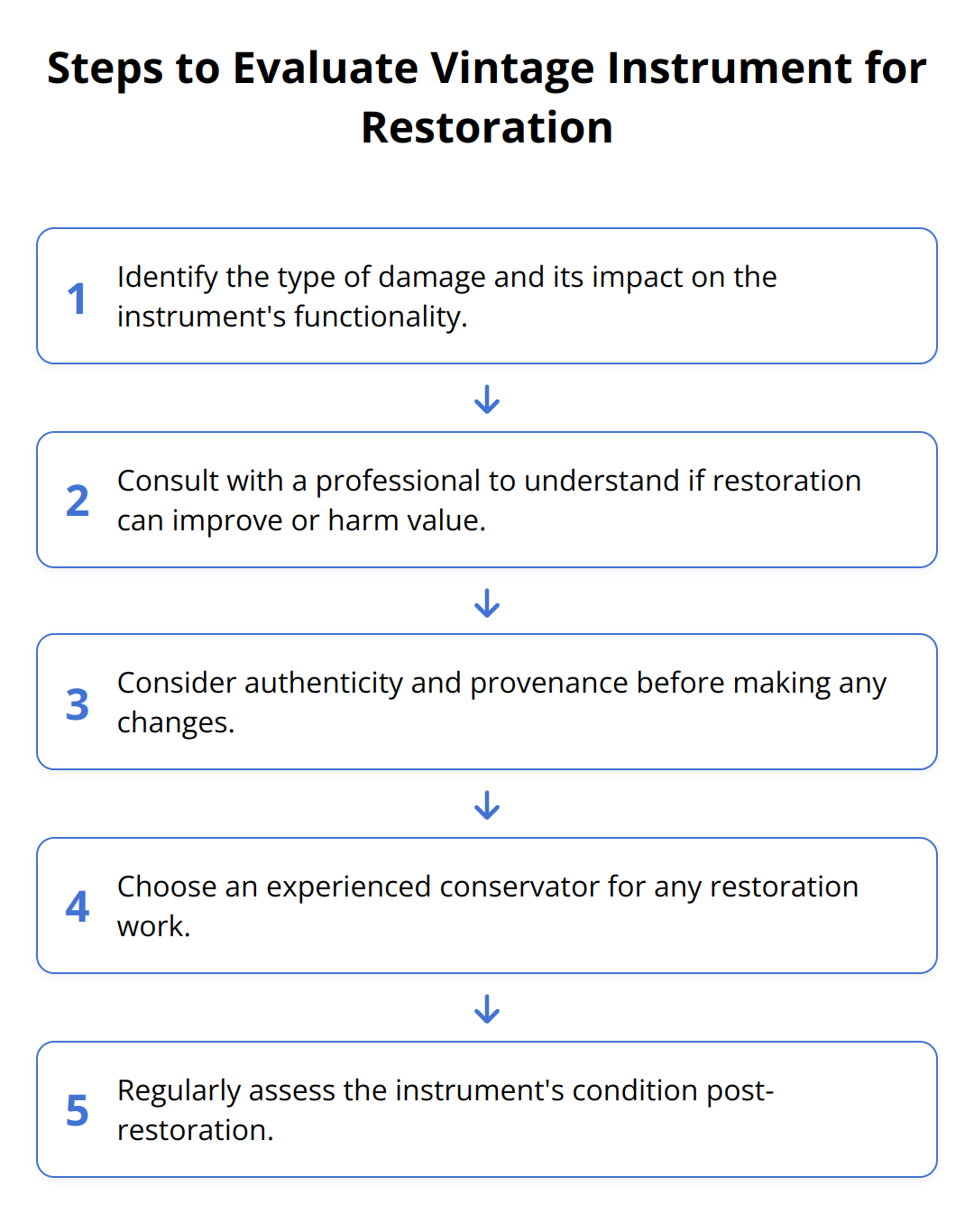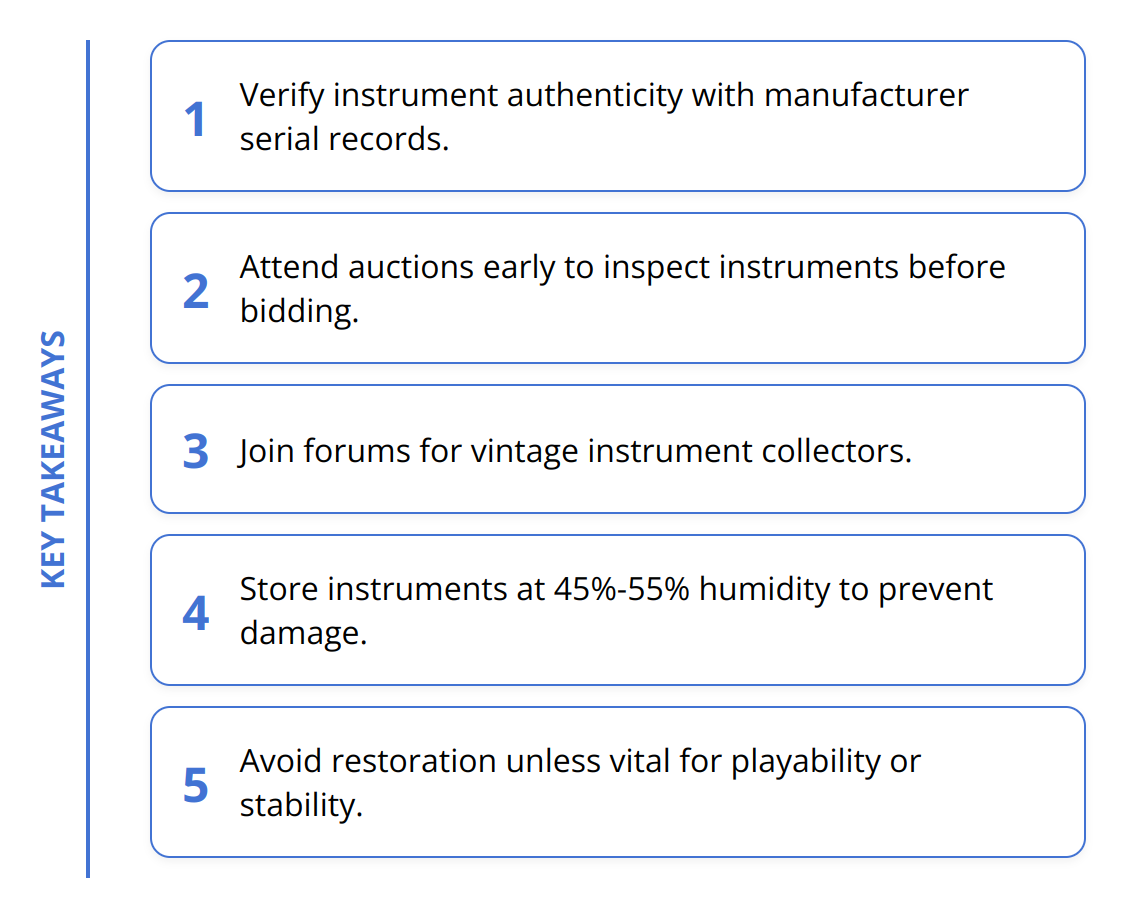How to Collect Vintage Musical Instruments

At Collectorizing, we understand the unique allure of vintage musical instruments. Their sounds carry stories from the past, offering a tangible link to musical heritage.
Navigating the journey of collecting these historic treasures can be both rewarding and complex. This guide aims to equip you with the knowledge to identify, source, and preserve vintage musical instruments, enhancing both your collection and appreciation for these exquisite pieces.
Identifying Authentic Vintage Instruments
The quest for vintage musical instruments is not just about adding pieces to your collection; it’s about connecting with history. However, the joy of acquiring a piece of musical heritage comes with the responsibility of ensuring its authenticity. Identifying genuine vintage instruments requires a keen eye, thorough research, and occasionally, expert verification.

Hallmarks of Age and Authenticity
Firstly, understanding the hallmarks of age is vital. Vintage instruments often have distinct signs of wear that are consistent with their age. Look for genuine patina on wood and metal parts, which should appear natural and not artificially applied. Another key indicator is the wear pattern, particularly on fretboards and keys, which can tell you a lot about the instrument’s age and use.
However, aging signs can sometimes be faked, so it’s crucial to compare these signs with known authentic examples of similar age and model. This comparison can reveal inconsistencies that hint at alterations or forgery.

Researching Brands and Models
Deep diving into the history of brands and models is essential. Many manufacturers have serial number records that can help date an instrument. Understanding historical specifications, such as the materials used during specific periods, can also be a giveaway. For instance, if a guitar is claimed to be from the 1950s but features materials not used until the 1970s, it raises a red flag.
Instruments with historical significance often have documented provenance. This documentation can include ownership history, repair logs, and even concert performances. Provenance not only authenticates an instrument but also enhances its value and appeal.
Using Experts for Verification
Despite best efforts, some vintage instruments can be challenging to verify independently. In such cases, consulting with experts is a wise move. Specialists in musical instrument appraisal have the experience and resources to authenticate instruments accurately. They consider various factors, including craftsmanship detail, material analysis, and manufacturing techniques that may not be obvious to collectors.
Professional appraisers can also offer insights into an instrument’s market value, which is crucial for making informed purchasing decisions. For those looking to delve deeper into instrument authentication, attending workshops or seminars can provide valuable knowledge and networking opportunities with other collectors and experts.
Actionable Tips:
-
Always verify the serial number with manufacturer records.
-
Attend collector meet-ups to exchange knowledge about identifying authentic pieces.
-
Consider the instrument’s history and provenance as part of its authenticity.
By adopting a methodical approach to identifying authentic vintage musical instruments, collectors can safeguard their investments and ensure their collections are genuine representations of musical history.
Sourcing Vintage Instruments
Finding the right vintage musical instruments is just as important as identifying them. Once you’re equipped with the knowledge of what makes an instrument truly vintage and authentic, the next step is to discover where these hidden gems are located. The journey to uncover these treasures requires patience, persistence, and a well-informed strategy.
Tapping Into Auctions and Estate Sales
Auctions and estate sales are gold mines for vintage musical instruments. They often house pieces from private collections that are rarely found in the general market. The key to success in these venues is preparation. Research upcoming auctions and estate sales in advance, noting any lots that feature musical instruments. These events can sometimes feel overwhelming, but with the right preparation, they can prove incredibly rewarding.
It’s wise to arrive early and inspect the instruments personally. This hands-on approach lets you examine the condition, authenticity, and overall value of the instruments. Remember, the competitive environment of auctions can inflate prices, so set a budget and stick to it to avoid overpaying.
Exploring Specialized Online Marketplaces
The digital age has brought the hunt for vintage musical instruments online. Specialized marketplaces offer a vast selection, from everyday pieces to rare finds. Websites like Elderly Instruments provide a platform for buyers to explore numerous listings, complete with detailed descriptions and images.
When navigating online marketplaces, thoroughness is key. Ask sellers for additional photos and information if needed. Check the seller’s ratings and reviews to ensure they are reputable. Finally, be aware of return policies and authentication guarantees to protect your purchase.
Networking with Fellow Collectors
Never underestimate the power of community. Joining forums and groups dedicated to vintage instrument collecting can unlock invaluable resources. Fellow collectors often share insights on where to find the best pieces and may even offer items from their own collections for sale. Engaging in these communities opens up opportunities for trades, sales, and shared knowledge.
Attending collectible shows and exhibitions is another excellent way to network. These events bring together enthusiasts and experts in the field, allowing for direct interaction and learning.
Actionable Tips:
-
Bookmark auction house calendars.
-
Regularly check listings on reputable online marketplaces.
-
Join vintage musical instrument forums and social media groups.
-
Visit local music shops known for vintage collections.
-
Subscribe to newsletters from auction houses and vintage instrument dealers.

By leveraging these strategies, collectors can enhance their chances of finding valuable vintage musical instruments. The search might be challenging, but the rewards of owning a piece of musical history are unmatched.
Preserving Vintage Instruments
Ensuring the longevity and maintaining the integrity of vintage musical instruments is a critical aspect of collecting. These cherished pieces not only embody historical significance but are also often irreplaceable. Proper care, handling, and storage are paramount in preserving their condition and, by extension, their value.
The Art of Proper Cleaning
Cleaning your vintage instrument is not just about aesthetics; it’s about preservation. Use gentle, non-abrasive cleaners specifically designed for the material of your instrument. For wood instruments, avoid using water or alcohol-based cleaners as they can damage the finish and wood grain. Instead, opt for professional-grade wood polish. Metal parts can be carefully cleaned with a dry, soft cloth to avoid corrosion. It’s imperative to avoid household cleaners, which often contain harsh chemicals that can degrade the materials.

Smart Storage Solutions
Storage plays a monumental role in preserving these treasures. Humidity and temperature are the two biggest factors to consider. Ideally, instruments should be kept in a controlled environment, aiming for a humidity level between 45% to 55% and avoiding extreme temperatures. Excessive dryness can cause wood to crack, while too much moisture can lead to mold and warping. Invest in a good quality case for each instrument and consider adding a humidifier or dehumidifier to your storage space to maintain stable conditions.
Safe Handling and Display
Handling vintage instruments requires mindfulness. Always wash your hands before touching your instrument to avoid transferring oils and acids that can corrode materials. When displaying your collection, ensure that stands and mounts are sturdy and appropriately sized. Direct sunlight can fade and damage instruments, so position them away from windows or in areas where sunlight is diffused.
Knowing When to Restore
Restoration should always be approached with caution. Authenticity and originality are significant factors in an instrument’s value. In many cases, it’s better to leave minor wear as it is rather than risk altering the instrument’s original state. However, if an instrument suffers from significant damage that affects its playability or stability, seeking professional restoration is advisable. Trust only experienced conservators who specialize in vintage instruments to handle such delicate tasks.

Practical Tips:
-
Use a digital hygrometer to monitor humidity levels.
-
Rotate displayed instruments to mitigate potential damage from environmental factors.
-
Keep all maintenance and restoration records as they contribute to the instrument’s provenance.
Preserving vintage musical instruments allows them to be enjoyed by future generations while maintaining their historical and monetary value. With diligent care and thoughtful preservation techniques, collectors can protect these pieces from the ravages of time, ensuring their legacy lives on.
For more insights on antique collecting, review our guides on antique surgical instruments and vintage toasters.
Final Thoughts
Collecting vintage musical instruments is a journey that merges passion with preservation. It’s about safeguarding slices of musical heritage and honoring the craftsmanship of eras gone by. The techniques discussed, from identifying authentic instruments to sourcing them and ensuring their preservation, form the backbone of a successful collecting endeavor. These practices not only secure the authenticity and condition of your collection but also enhance its investment value and your enjoyment as a collector.

The joy of collecting vintage musical instruments lies not just in ownership but in the stories these instruments tell. Each piece is a testament to the music it has created and the hands it has passed through. This emotional connection, coupled with the potential for financial appreciation, underscores the dual reward of collecting.
We at Collectorizing believe that the journey of a collector is ongoing and flourished through community involvement and continual learning. The landscape of collecting is ever-changing, with new discoveries and insights waiting around every corner. Engaging with fellow collectors, attending events, and staying informed through reliable resources are key to enhancing your collection and knowledge.
For those intrigued by the broader world of collecting, we invite you to explore Collectorizing. Our platform is a rich resource for anyone eager to dive deeper into the art of collecting, offering articles on a wide range of collectibles, from vintage toys to antique surgical instruments, and connecting you with a vibrant community of enthusiasts.
Whether you’re seeking to start your collection, searching for that next rare find, or simply looking to immerarbondur semore in the fascinating stories behind collectibles, remember:
-
Patience and research are your best tools.
-
Authenticity adds immeasurable value.
-
Preservation ensures legacy.
-
Community knowledge enriches your collecting experience.
Collecting vintage musical instruments is more than a hobby; it’s a lifelong journey of discovery, enjoyment, and stewardship. Happy collecting!



